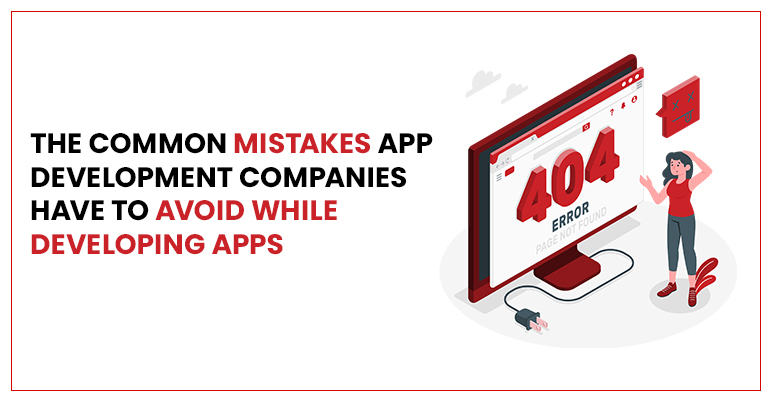The Common Mistakes App Development Companies have to Avoid While Developing Apps
August 20, 2021
admin
Software programs have, without question, get a lot of attention and traffic in recent years. Many people now regard them as a goldmine because of the enormous cash they provide.
However, a closer examination of the mobile application business finds that a startling number of apps are abandoned after their initial use. This is due to the digital market’s competitiveness. Apart from rivalry, there is a slew of blunders that mobile app developers do that jeopardize their products’ success. You may successfully position your app to become the reliable source of money you’ve always dreamt of by avoiding these frequent blunders throughout development.
FAILURE TO UNDERSTAND YOUR USERS’ NEEDS
Every productive part of the software is based on great user research. It’s normal for developers to believe that their software will be a customer favorite, especially in the early stages of development. However, your project may be doomed if you fail to validate this idea through a thorough understanding of your target audience. User research is critical to the success of the two most crucial components of bringing an app to market (development and marketing). This is why you cannot afford to make assumptions about the requirements and habits of your potential consumers. Successful user research must reveal information about specific user personas, demographics, motives, and behavioral patterns. You must also be aware of what your competitors are doing and create clear goals and objectives for developing a one-of-a-kind solution.
You must find answers to the following questions to design an app that will be popular with your users:
- Is the app’s design is going with the popular market trends?
- Are your app’s features well-designed and implemented? Will there be a lot to intake for the users?
- What is the app’s level of originality? App marketplaces are already clogged with a plethora of similar apps.
The most crucial strategy to get a head start on your project is to conduct audience research. You can save a lot of time by verifying your ideas and assumptions before putting them to work.
TOO MANY STAKEHOLDERS ARE INVOLVED
Any software development project necessitates decision-making. While having many project stakeholders might be beneficial, failing to manage them is a recipe for disaster adequately. In general, project stakeholders struggle to have their viewpoints understood. To accomplish this, project managers must devise a comprehensive strategy for attaining all of the project’s objectives. Identifying all the main stakeholders and their roles in the development process should focus on a standard project management plan. You should also give varying priority levels to each stakeholder’s interests while doing so.
This should be determined by how significant their contribution is to the project’s accomplishment. Selected roles such as decision-makers, feedback providers, and recommendation providers could be included in stakeholder hierarchies.
BUDGET MISMANAGEMENT
Poor budget management is another common app development blunder. App development is a significant business expenditure, regardless of the size or nature of your project. As a result, one of the most critical deciding elements to consider is the size of your budget and how it is managed. There are three guidelines you should consider from the start of the project to avoid risking your budget.
- Before you begin the development process, make a precise budget. Its usefulness and accuracy are primarily determined by how much research you conduct. Understanding your target demographic, app features, design components, and intended revenue approach will play a role in this.
- Set aside funds to cover any unexpected expenses. Unexpected events will always emerge, no matter how extensive your budget is. As a result, a smart budget should leave room for unforeseen costs.
- Follow the budget to the letter. Once you’ve come up with your ideal budget, make sure to stick to it even during the most critical stages of the project.
In a word, app development is a time-draining, flexible process. Though there isn’t a one-size-fits-all answer for funding it, good budgeting ensures that you always put your best strategy forward.
NOT COMMUNICATING WITH DEVELOPERS APPROPRIATELY
Communication is an essential part of any strong application development project, just as it is in any other company endeavor. Getting developers to see your application’s complete concept may appear to be a struggling battle, but it’s one you must undertake. How well you perform this can have a meaningful impact on the consequences. When communicating with developers, the best way is to leave no details out and make no assumptions. When it comes to an entirely new piece of software, complete documentation with all relevant pictures is essential.
Your app’s documentation should include a synopsis (a summary of what it does), an app wireframe, and a detailed feature list. In most circumstances, a professional developer will expect you to provide these items. In exchange, the developer or agency will provide feedback and generate a project price. You can gain insight into the developer’s communication method and decide if it works for you during this initial interaction. However, keep in mind that this stage of the development process is not standardized. Putting in your research input from the start, though, can save you a lot of time and effort in the long run.
USING YOUR WEBSITE OR DESKTOP APP AS A MODEL
You’ll almost certainly already have a web app before attempting to create a mobile app. There’s a good possibility you’ll fall in love with this web or desktop app. Choosing to duplicate your web app in your mobile app, on the other hand, is rarely a wise option. The reason for this is simple: mobile and web apps function differently. The User Experience (UX) criteria for both products are different. A mobile app should not simply be a “miniaturized” version of your desktop software. It’s critical to emphasize this from both a functional and a design standpoint. Consumers use smartphones and desktop computers in different ways by default. As a result, both the feature list and the design decision should reflect this disparity.
Your mobile app (as a native app) should provide the best possible performance under ideal conditions. Your selection of design elements and functionality will aid you in fulfilling this! While it’s great to have a consistent color scheme and theme throughout the app (for branding considerations), its UX should always come first.
The majority of large brands offer a variety of app solutions for various device platforms. App developers are frequently tempted to follow in their footsteps in an attempt to learn from them. Unfortunately, making this decision early on has often proven to be a mistake. Developing your software for several platforms, without a doubt, is a specific approach to reach as many customers as possible. The considerable caution here is that you should avoid pursuing too many platforms at the same time. The first disadvantage of this strategy is the financial cost. Creating an iOS and Android app at the same time, for example, is a massive undertaking. Because all responsibilities will be performed as separate projects, you’ll need nearly double the funding that one platform demands. This isn’t a good business model for a new app.
ENDNOTE
Creating an app is sometimes a long and complicated process over a long period. It is common for Developers to make mistakes because of human nature which is not perfect all the time, along the route that will jeopardize the app’s success. Poor development processes include a lack of understanding of consumers’ demands, including too many stakeholders, and ignoring user retention rates, to name a few. At Technbrains we take care of all of these things and only offer expert services that can be used in a long run without hassling around.





